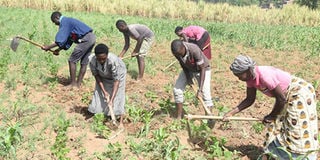Failed rains shouldn’t dampen Kenya’s growth and prosperity

Farmers at Shitinji village in Kakamega County cultivate their maize farm as rain fails. The country is facing food insecurity. PHOTO | ISAAC WALE | NATION MEDIA GROUP
What you need to know:
- When the rains fail, all economic and social indicators deteriorate. The costs of food and other essentials rise steeply as the economy falls into recession.
- We should invest more in innovative systems, including technology-driven water harvesting, extraction and management practices.
So, we all should brace ourselves for a long, painful year just because the rains have failed.
The heart-breaking news from the Met department is that the long rains won’t be enough to underpin the recovery of agricultural production.
Unusually, high temperatures across the country signal disaster ahead. Rivers are running dry at an alarming rate, significantly reducing water for domestic consumption, irrigation and electricity generation.
Serious water shortages are already being felt. In Nairobi, the city water supplier has issued a rationing schedule to the ever-rising urban population that, in any case, never gets enough water even when the entire country is flooding.
In the pastoral and marginal agricultural areas, the situation is so grave that thousands of families are stressed due to lack of food and water.
FOOD INSECURITY
By February, over 1.1 million Kenyans mostly in the arid and semi-arid counties needed food aid, according to the Famine Early Warning Systems Network — a USAID initiative that provides evidence-based analysis of food insecurity in 34 countries.
The situation is so dire that 800,000 of these desperate Kenyans are experiencing a food crisis, arising from the failure of short rains towards the end of last year.
The remaining 300,000 are reportedly experiencing food stress but are likely to fall into crisis if the situation remains precarious.
The FEWS Net report published in March, based on an assessment by the Kenya Food Security Steering Group, warns of increased moisture deficits from “abnormal dryness” due to the failure of the rains and high temperatures in Kenya and other countries in the Horn of Africa, including Ethiopia, Uganda and Tanzania.
ECONOMY
As the crisis unfolds, the number of people in need of food aid is likely to rise significantly, and the situation can quickly deteriorate to emergency or famine.
The government and humanitarian aid agencies should be engaged in massive mobilisation of food and drugs to prevent starvation, particularly in highly vulnerable areas in Turkana, Garissa, Marsabit, Isiolo and Tana River counties.
These reports illustrate the extent to which the lives of Kenyans are eerily trapped by weather patterns.
A good economic period is defined by enough and well-distributed rains that underwrite a bumper agriculture and livestock output that keep processing industries alive and creating jobs.
Moreover, increased water in the dams feeds into consumption, irrigation and hydro power generation.
When the rains fail, all economic and social indicators deteriorate. The costs of food and other essentials rise steeply as the economy falls into recession.
PREPARATION
This is what happens when the government and the people look up to the sky each day for miracles to transform Kenya into a food secure country.
Poor planning and misguided dependency on grandiose projects contribute to economic crises that should be resolved by simple solutions but are, instead, subjected to costly time-wasting procedures.
The cycle of rain and drought is well-known. It used to happen every four years but due to global warming, it has become more frequent, with one good year almost inevitably being followed by a bad one.
The cycle is nearly as predictable as day and night. So, well-designed programmes should be scaled up to mitigate the adverse impact of both the rains and drought.
The catastrophic unpreparedness of the authorities whenever drought comes calling is shocking. It is presumably a reflection of how development priorities are captured by merchants of fortune.
OVERAMBITIOUS
The government's mentality is that grandiose projects, such as mega dams, solve economic and social problems, but they don’t.
Instead of spending Sh21 billion on mobilisation and preliminary costs for two large dams that haven’t taken off, for instance, the government should have built over 5,000 boreholes and water pans (at Sh3-5 million each) that could have rapidly improved the livelihoods of the millions of people whose survival is now at stake due to chronic water and food shortages.
Sustainable food and nutrition security, which is one of the government’s Big Four plans, cannot be achieved by investing in expensive projects whose implementation is controlled by political interests and cartels.
The failure of the rains shouldn’t dampen Kenya’s prospects for growth and prosperity. Rather, it should be an important lesson to invest more in innovative systems, including technology-driven water harvesting, extraction and management practices.
Mr Warutere is a director of Mashariki Communications Ltd, [email protected]





